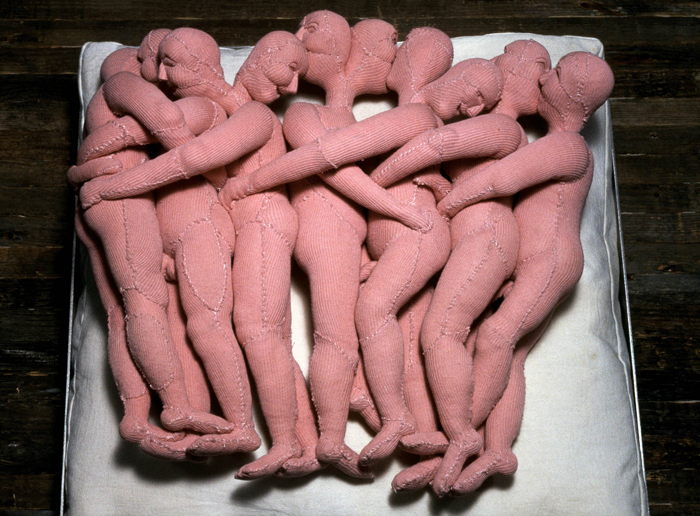
There are multiple points of entry into any consideration of Louise Bourgeois’s work, a body of work that spans decades and many different forms. With some hesitation, I choose to take up the lure of narrative, which Bourgeois has herself provided: “All my work in the past fifty years, all my subjects, have found their inspiration in my childhood.”1 In a sense, this is precisely what is expected of women artists; Bourgeois throws out the bait to us, well aware that her audience expects and demands such “personal” information. Yet Bourgeois gives the outlines of her family plot in such schematic form, it seems almost to function as a decoy, a distraction from the actual complexity of her life story. By pointing the critic and the historian back to her myth of origins, she deftly moves our attention away from the rest of her life–the thirty-five year marriage to art historian Robert Goldwater, her three sons, the long struggle to make art.
Over and over again, Bourgeois speaks of the function of art-making as a way to deal with the past. She writes: “Some of us are so obsessed with the past that we die of it…. Every day you have to abandon your past or accept it and then if you cannot accept it you become a sculptor.”2The ancient family drama that continued to sustain and fuel her work is, however, very ordinary. Bourgeois’s father was unfaithful to her mother with her governess. A simple story. But dig a little deeper, and there’s a lining, as Freud would say, to this structure: her governess therefore was unfaithful to Louise with the father.3Further, the (invalid) mother apparently acquiesced, implicitly using Louise to keep an eye on the (illicit) love affair. That Sadie, the governess, was English, employed to teach Louise the language that would become the language of her future husband and her exile in America, only gives the structure deeper roots.
Nevertheless, there are no surprises here; it’s a family plot so commonplace as to seem interchangeable with a thousand others, especially of that era. Sadie lived with the Bourgeois family off and on between the years 1922 and 1932, when Louise was eleven to twenty one. Six years older than Louise, she was supposed to teach English to the children and to drive the mother around. Later, the mother was keen for Louise to get her driver’s license, so she wouldn’t have to be driven by Sadie any longer. The mother died in 1932, the same year Louise studied calculus and geometry in Paris, the same year that Sadie apparently vanished from the scene.
That’s it; that’s the story. It reminds me of the case histories in Freud and Breuer’s Studies on Hysteria, where a young woman becomes incapacitated because unconsciously she is in love with her sister’s husband; she can’t walk because she wants to lean on him.4Another young woman loses the power of speech; she finds herself re-enacting the year she spent at her father’s deathbed. In Studies on Hysteria, it becomes clear that the great mystery Freud uncovered is the unspoken secret of the modern family: we’re all helplessly, unavoidably, in love with each other. unconscious desire determines our relations with the people who surround us, people we do not choose: our parents, servants, teachers, siblings. Between the incest taboo and society’s expectations, we live out the tragedy of these impossible loves. Within the context of hysteria, such unspeakable wishes manifest in the body; thus hysteria is “a malady through representation,” with symptoms that speak what cannot otherwise be represented.5
Freud’s case history of “Dora” also comes to mind, involving a daughter, a father, his lover, and at least one governess.6 In this structure, Dora is implicitly “handed over” to her father’s lover’s husband, as the price for the husband’s acquiescence to the adultery. Dora balks, refusing to participate in the exchange, in part because she understands that her compliance within the system of accepted (if unacknowledged) infidelity can only mean her subordination, accepting a position she shares with the governess, the seduced and abandoned nursemaid. Yet the pressure to collude is so great that to break from it makes her physically ill: speechless, coughing, suicidal. Paradoxically, these symptoms provide a route to speech, to the place that she and Freud open up, a space where at least some aspects of her unspeakable desire can be recognized, however imperfectly.
If the model of hysteria that Freud proposes is one where repressed and forbidden ideas or wishes are converted into physical symptoms, I would argue that Bourgeois’s work parallels this structure, in the sense that her sculpture takes the place of the body as the site for this conversion, as the locus of a very controlled form of symptomatic speech. Bourgeois writes: “Since the fears of the past were connected with the functions of the body, they reappear through the body. For me, sculpture is the body. My body is my sculpture.”7Freud’s concept of hysteria insists that unconscious desire manifests itself in symptoms, which are, by definition, repetitive. (It’s not a symptom if it doesn’t come back.) Ideas take shape in bodily anaesthesias–numbness, tingling, surges of nervous sensation, distortion–a spasmodic seizing up of the musculature, and through dysfunction–loss of voice, or the inability to stand or walk. Bourgeois’s Personages (1945-55), a group of over eighty sculptures, address the difficulty of verticality, as if to stand up and be a person is itself a struggle we all know too well.
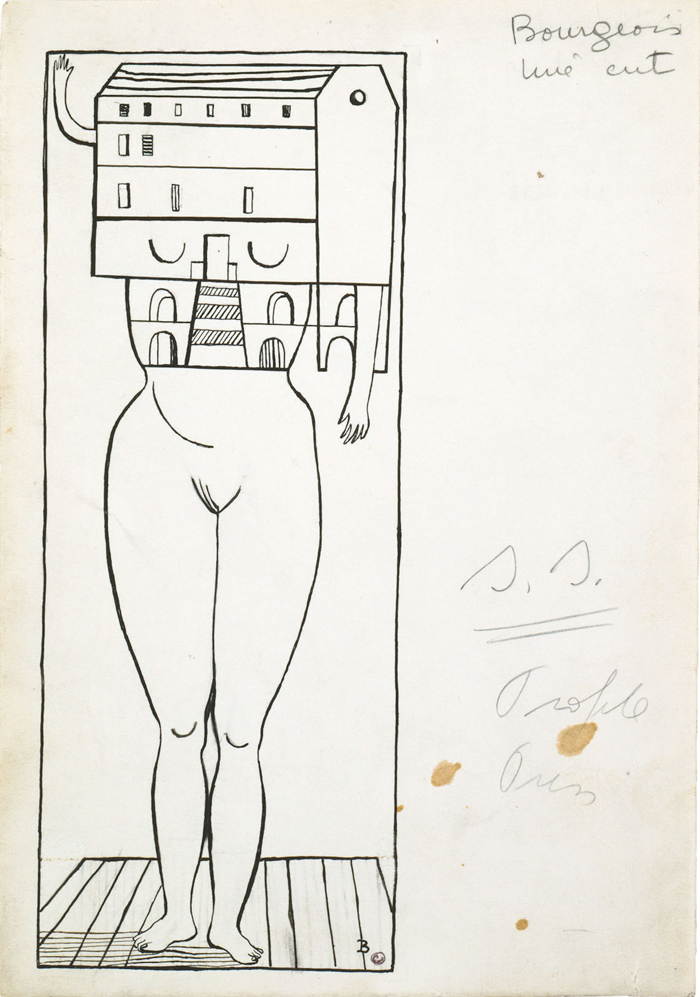
Most telling is Freud’s idea that all symptoms are “compromise formations,” constituted in the collision between the forbidden wish and its suppression.8 The hysterical symptom is therefore necessarily a hybrid form, in two different senses: it is both psychic (that is, a mental event) and embodied, and it is both enunciated and repressed, at the same time. Each expression bears the scars and bruises of its troublesome disclosure, while in the context of hysteria, the forbidden idea necessarily manifests as material object, three dimensional, in the world. (Bourgeois stopped painting because a painting wasn’t enough of an object in the world. I would argue it wasn’t enough like a body, because that’s what the three-dimensional form is for her. Her drawings became like writing, or musical annotation, as the counterpart to this object in the world.)
In 1889, Freud travelled to Paris to study with Jean-Martin Charcot, at the Salpetriere, the enormous asylum over which Charcot presided in a form of benevolent despotism. Charcot’s strength was nosology, the identification of patterns of symptoms that could then be said to constitute a syndrome, a disorder, or a disease. His project was to systematize the multifarious and contradictory symptoms that fell under the heading of hysteria. Charcot’s lecons du mardi (Tuesday lessons) were public demonstrations of symptomatic display and diagnosis before an audience, which included doctors as well as “society” people who came for the show. Additionally, a photographic studio was set up inside the hospital, and hysterical patients were required to perform for the camera. Needless to say, the patients who performed most reliably and dramatically were implicitly rewarded in all sorts of invisible ways.
The Iconographie de la Salpetriere is a series of volumes in which these extraordinary photographs were published, documenting the precise sequences of states that constituted Charcot’s idea of the “grand” hysterical attack.9 Certain patients, notably “Augustine,” reappear in multiple presentations, like actresses repeating a role. (After years of performing, it’s encouraging to know Augustine eventually escaped from the asylum, disguised as a man.)10The climax of these sequences, implicitly demanded by Charcot, was the arc-de-cercle, where the body arches backwards, resting all its weight on the head and the heels, in a spasm that holds the arched body in suspension, barely long enough for the photographer to capture.11
These images can be seen as the historical substructure to Freud’s theories of neurosis: Charcot’s Salpetriere was an institution that recognized the women’s symptoms only when they were presented in visible form. Freud’s revolutionary shift was to begin to listen to his patients, to interact with them as speaking subjects, as opposed to Charcot’s insistently visual and spectacular construction of them as objects of study. That the special conversation that is psychoanalysis should prove therapeutic makes sense. Symptoms become accessible to interpretation through language; the body is no longer obliged to bear the entire burden of representation, although it may still “enter into the conversation” periodically. Hysteria fades into history.
In her sculpture, Bourgeois returns to Charcot, leapfrogging over Freud, in a move that underlines the usefulness of Charcot’s relentless visuality. I believe she nevertheless retains Freud’s conception of hysteria as an embodied form of hybrid communication, bearing the marks of its repression. In Cell (Arch of Hysteria) (1992-93), Bourgeois replaces the female bodies of the Iconographie with a young male body, armless, headless, arched on a low bed on which the words “Je t’aime” are embroidered in rows, like the lines that are given as punishment in school. In Arch of Hysteria (1993), a hanging figure, again of a young man, is cast in bronze and polished to a liquid reflection. Bourgeois underlines the vulnerability of a male body, as she allows the distorted form to turn slowly in the air. This piece and Cell pose a series of questions: is this pain or pleasure? Is this love or illness? Is this jouissance, or some form of repetition compulsion, a punishment re-enacted in the repetition of the red words, je t’aime?
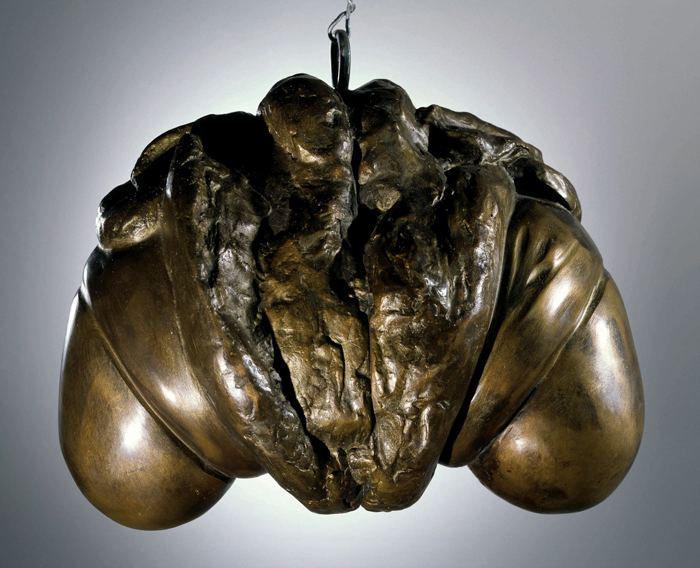
Bourgeois has explored the suspended form in multiple sculptures, perhaps most notoriously in Fillette (1968) and the Janus series (1968). Together with her Personages, many of which have the merest toe or point on the floor, the hanging work marks its detachment from the ground. The suspended object gyrates slowly in a spiral, a movement that contradicts the implicit weight and stability of traditional sculpture. It is a gesture that counterbalances the substantiality of the embodied shape, insisting on its conceptual dimension. It’s an imaginary, hypothetical body proposed in these works, and suspension allows uninterrupted consideration of the “part object,” referencing both male and female body parts, which we see from below, like a small child looking up at its mother’s body.12
It is also striking that the “arch of hysteria” reiterates the arch as a form, a primal shape that allows Bourgeois so intimately to connect rounded body parts (breasts, heads, the entire arched torso) to architecture. Explicitly returning to Charcot’s visual vocabulary allows the visual and the embodied to take the place of speech or language in a concrete manifestation of psychic realities, with the three dimensional artwork taking the place of the body.
In a sense, I look at Bourgeois’s sculptures themselves as “compromise formations”; that is, they follow a logic that structures the formation of symptoms. Materials resist the artist; they push back. Formal decisions (to place the piece on the ground, to suspend it, to enclose it, expose it, and so on) and its materiality (stone, fabric, plaster, latex, wood, metal) reveal the place where we can trace the struggle of hybrid communication, where resistance leaves its mark, irrevocably shaping the utterance. While the human body is represented in Bourgeois’s work, it is never other than a symbolic body, a manifestation of a set of contradictory ideas. Bourgeois’s bodies are most often incomplete, taking the form of body parts, or of torsos missing a head or feet. When she represents bodies that are whole and entire, their fictionality is emphasized in the materials used, like fuzzy fabric of an unnatural pink, in order to make clear that we are in the artist’s inner world, nowhere else. Gender fluidity is reiterated, in forms that invoke different body parts in their weight, softness, droop and sag.
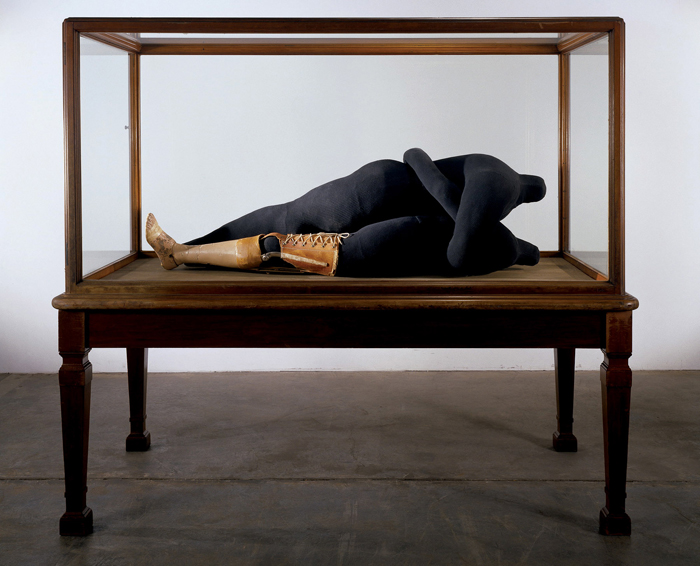
One of the most curious details of the hysterical body as described by Freud is the way it is broken up into segments, these sections delineated by imaginary or cultural boundaries, rather than anatomical realities. For example, one of the ways a doctor could determine whether a patient’s numbness or tingling was hysterical (rather than a sign of physical illness) was to chart these lines of fragmentation drawn on the body. If the “arm” was described as that part of the body that begins at the line of the seam where the sleeve is attached to the bodice, then it was, so to speak, an imaginary arm, culturally determined by clothing. It was a conceptual arm, a psychic representation of an arm. In this sense, hysteria produces an imaginary body, made up of parts perhaps temporarily sewn or hung together, parts that can too easily come apart again, in the corps morcele, the body-in-pieces.13 It is a fabrication, a representation, like a giant doll. Bourgeois finds multiple ways to get at this imaginary body and its “part objects,” those often hanging or extruded elements, which have the capacity (in imagination) to detach and become a thing in the world. The idea of the transitional object comes to mind, mediating between the subject and a world full of objects.14 over the decades of her practice, she has used different materials and processes to materialize her relationships to such imaginary objects.
In her Personages, vertically oriented structures that hold multiple pieces of wood in a structure of accretion, the crucial significance of found materials, discards from the streets, becomes apparent. It is a process that involves salvage, first, and then cutting, shaping, and finally a kind of assembling of the set or stack. Bourgeois’s delight in cutting, drilling, chiselling, is a contrary motivation to the act of salvage, as if each sculpture enacts an emotional series: initially to rescue the overlooked and neglected “found” material from the wide open spaces of the world, then to cut and shape it, allowing an almost sadistic pleasure in making it submit to the sharp implement, and finally to put it all back together again, in a gesture of reparation which almost makes up for the aggression, the hate and joy in hating, but not quite.15
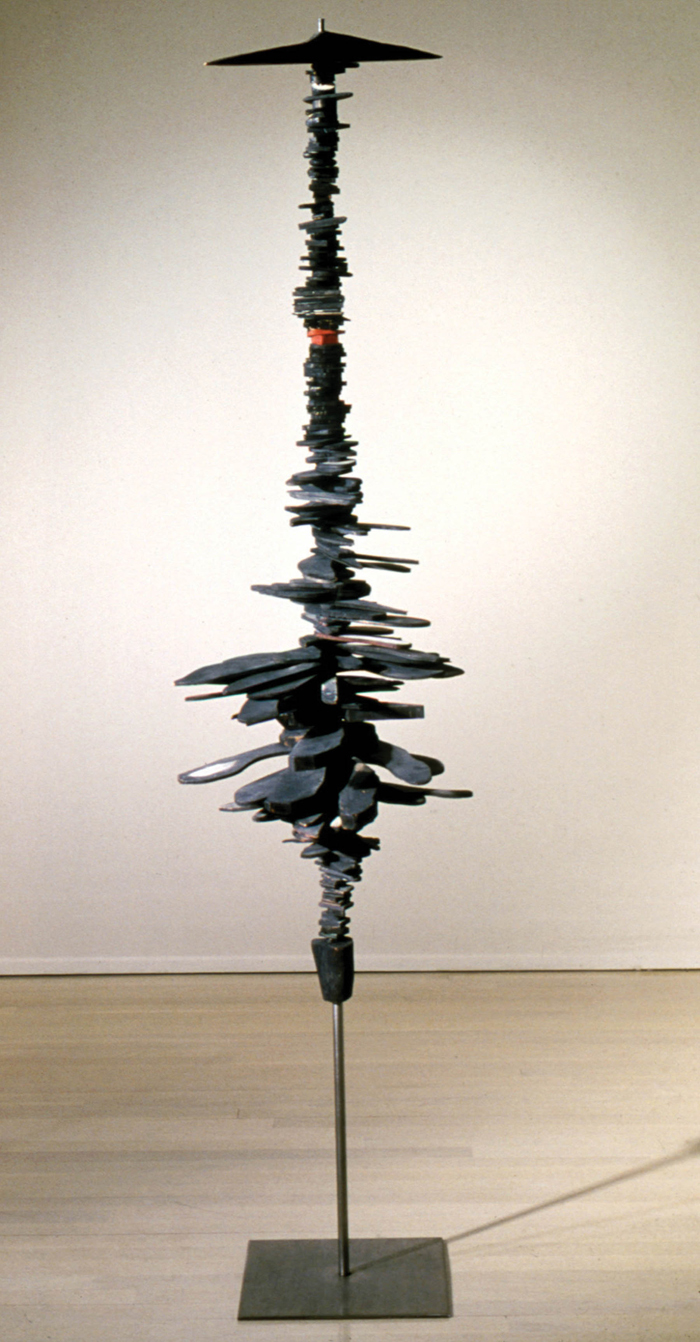
Her hanging sculptures emphasize the droop, the pour of embodied part-objects that have found a way to separate, to detach. Here are the penises, the breasts, draped over each other, the bronze spiral twisting in space, the arched body hanging suspended indefinitely. Asked about the notorious Robert Mapplethorpe photo that shows a grinning Bourgeois holding Fillette (1968) under her arm, Bourgeois speaks of taking along “a piece of mine” to the photo shoot as “a precaution against a catastrophe.” She goes on to say that she dislikes being photographed, and she “counted on” what she brought with her, that is a monkey fur coat and Fillette, to get her through it. The interviewer asks: “Why did you choose a large phallus?” Astonishingly, Bourgeois replies: “It is not a phallus.”16
She’s right, of course; it is a phallus, and it’s not a phallus, resembling as it does the distorted baby, wrapped in a blanket, upon which she bestows the title fillette, meaning little girl, une petite fille. (Mapplethorpe’s published contact sheets from the shoot show Bourgeois holding Fillette in her arms like a baby, cradling it, and by this gesture, before our eyes the balls become its legs, the head seems enclosed in a baby’s bonnet.)17 In other words, this giant gnarly phallus also takes the form of something one feels protective towards, something to cradle and rock, something reassuring that itself needs to be reassured. Again insisting that men’s bodies share something of the vulnerability that women’s bodies so often represent, Fillette is both the love she feels for the precious bodies of her husband and her three sons, and the monstrous appendage women (according to Freud) apparently lack.18 At the same time, in a further twist, the petite fille is no other than Bourgeois herself, “a little Louise” as she puts it.19
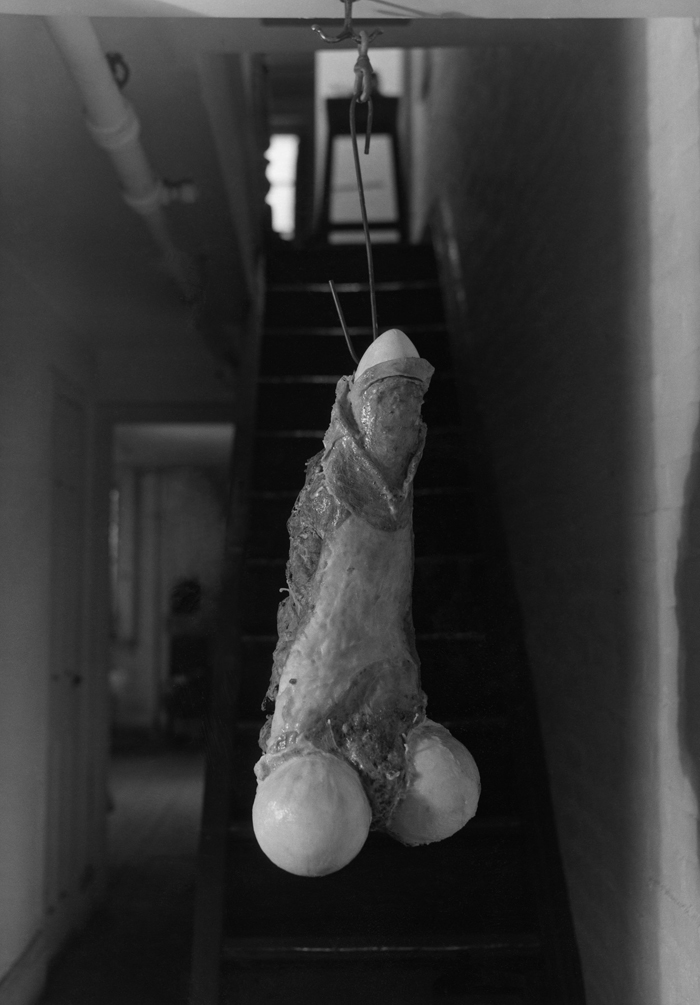
Then, as if to make a joke of the protective feeling, and the vulnerability, undoing all this, she skewers the thing with a hook and hangs it from the ceiling in the hallway, bringing it all back home, to castration, to the capacity of part-objects to detach, to be interchangeable, to morph into each other in an endless exchange.20 (Freud’s own equation is “penis-baby-feces,” to which followers of Melanie Klein freely add “-breast.”).21 The grisly latex-on-plaster surface of the penis-baby Fillette may indeed bring feces into the conversation, as the perpetual play of signification resists any settled definition of this object as one thing or another, male or female, powerful or vulnerable, big or little, father or child. So it is not, it cannot be a phallus, because it is not and can never be one thing.
The investigation of soft and hard, which led to Bourgeois’s use of latex and plaster in the early 1960s, eventually took her to Pietrasanta in Italy, to marble. She drilled, cut and polished marble to make forms that are both very hard, very heavy, almost immoveable, and at the same time soft and organic, invoking the tender parts–eyes, breasts, penises–in the bulbous arched forms of Cumul I (1969) and its siblings. It’s as if the various sides of making, involving salvage, aggression, and reparation, have found another site, in the intense fabrication process of cutting marble. In this material, Bourgeois proposes another stage in the undoing of oppositions: organic vs. mineral, soft vs. hard, pouring/drooping vs. solid rock, alive vs. dead.
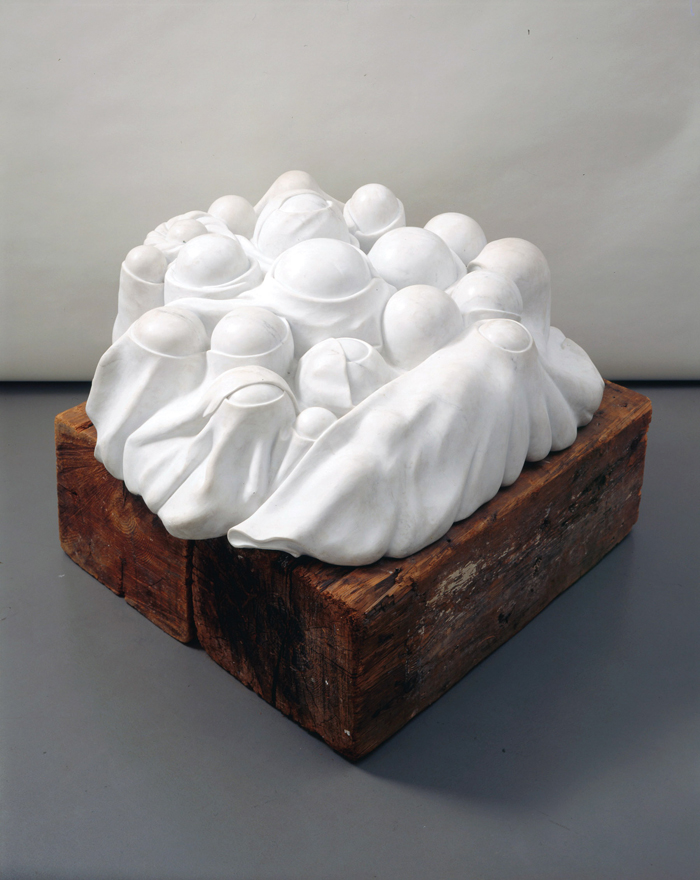
Later still, Bourgeois makes the Cells, self-contained, room-like spaces, cut out of the gallery, where she takes possession of the space to make a context for the objects placed inside. The objects include found furniture, her own clothing, heavy steel evocations of a guillotine, a sewing machine, and occasionally her own sculpture from previous years. By making a provisional room within the gallery, she no longer has to rely on the gallery or museum to provide a context for the objects, and she can make a configuration, a collection or accumulation, which allows the objects to speak to each other, as if inside the artist’s inner world. She has stated that the Cells are specifically about pain, and certainly prison cells connote a kind of torture, an immobility in the face of past deeds. What was done cannot be undone, it can only be reconfigured, reassembled, in material form.
Beginning with hinged plates of steel marking out a circular space, Bourgeois used old doors, or old doors with windows, and later, a heavy metal mesh, to delineate the space of the cell. Repeatedly, she placed inside the Cells a cheval glass, that is, an oval or round mirror supported on each side, allowing it to tilt back and forth. Amazingly, in French these mirrors are called “psyche,” in fact that is the first definition of the word in my dictionary. The doors, windows, and metal mesh are all quotations, so to speak, from the architecture of the Lycee Fenelon in Paris, where she was a pupil from the age of eleven to sixteen. Photographs of the Lycee appear in Makhi Xenakis’s book Louise Bourgeois: The Blind Leading the Blind,22 where the seemingly endless repetition of half-circle arches over the large doorways and windows in the school invoke Bourgeois’s many repeated arched forms, notably the series Cumul, her sculpture Partial Recall (1979), the arch of hysteria, and the half circle iron bedsteads which appear in the Cells.
Of the Cells, Bourgeois has said: “‘Cellule’ Communiste, ‘cellule’ in a prison, and very very especially, the ‘cellule’ of our blood. That is to say, little entities that are next to each other and are different from each other.”23 Each Cell is proposed as a whole, complete in itself, yet also a link in a chain, or a part of a larger set. Each contains a selection from Bourgeois’s image repertoire; the Cell is like a life-sized version of her mind. In some instances, the viewer is invited to move inside the space, to be enclosed with the various objects placed in such careful juxtaposition. The looking in, and out, set up a scenario of voyeurism: “the thrill of looking and being looked at.”24While it remains indeterminate precisely who is looking, and who is enjoying being watched–precisely where the pain is, and where the pleasure–the cells themselves have the potential to accumulate, making a larger whole, or to break apart, to detach. In other words, the procedures of salvage, cutting, and accumulation persist, finding different forms and materiality as time passes.
The mirrors that are called “psyche,” the spaces she designates as “cells” (with all the different meanings of that word), the drawings that take the form of a written phrase, repeated, her punning and poetic titles, all these and more require any consideration of Bourgeois’s work to acknowledge the place of language in it. I am particularly struck by the power of her titles to transform the work. In a set of 77 framed drawings entitled Tous Les Cinque (2004) each sheet (apart from the title page) shows a target form, red painted circles within circles. In the context of the title–“all the fives”–it becomes clear that there are five circles in each drawing, one inside the other.25I am reminded that there were five people in Bourgeois’s family; I see the blue outline that constructs one of the circles as a “psyche” (a tilting mirror), and this allows me to think of the drawings as yet another controlled self-presentation. The simplicity of the target shape opens up a series of associations: we find, again, embodied forms (eyes, breast, orifice) but it is their repetition that invokes a certain state of mind, perhaps contemplative, perhaps insomniac. (Bourgeois draws at night when she cannot sleep.) While the use of language in her work is always ironic, that is, multivalent and wry, ultimately language materializes as form, as another object to work with, or out.
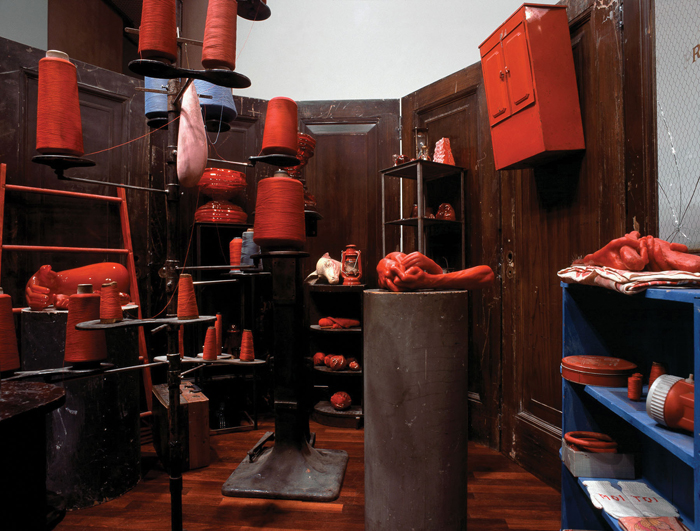
To return, finally, to the question of the story of origins, the narrative of childhood that apparently provides the inspiration for her work, the question becomes: why go back? Why reactivate the betrayals belonging to the distant past, way back then? What is it about this set up–the father and mother, the daughter, the governess–that remains compelling seventy years later? Reading the interviews and texts, one answer becomes clear. It is a simple one: the story, such as it is, can still make her angry. one way or another, whether remembering her love for Sadie (betrayed), her wounded mother, her charming father, however she gets there, it takes her to anger, to the place where passivity (and pain) flip over into activity (and making). “The subject of pain is the business I am in. To give meaning and shape to frustration and suffering.”26 Each piece emerges in the move from suffering to meaning, as the artist moves herself from the position of sufferer to the position of maker of meaning. That is the move–from victim to agent–which these works re-enact, decade by decade, making a space for Bourgeois to undo and do again the work that is so undeniably her own.
Leslie Dick is a writer who teaches in the Art Program at CalArts.
